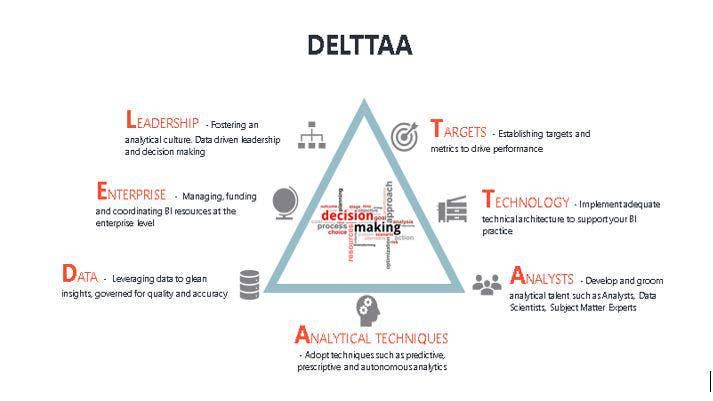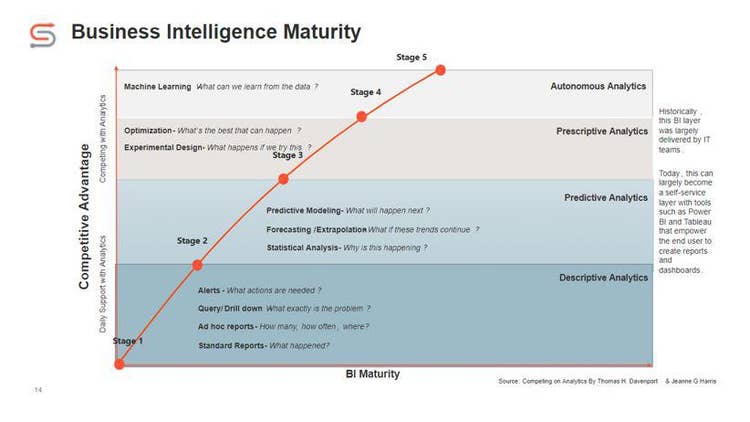The Channel Angle: Tips to Accelerate Data-Driven Insights and Boost Business Intelligence
‘Using data resources effectively allows organizations to align services or products directly with customer feedback, increase business intelligence maturity, and forecast future trends,’ writes Synoptek’s Debbie Zelten in The Channel Angle.

[Editor’s note: The Channel Angle is a monthly CRN guest column written by an executive that focuses on the triumphs and challenges that solution providers face. If you are a solution provider executive interested in contributing, please contact managing editor David Harris.]
By Debbie Zelten
Data-driven insight continues to change how business decisions are made, how customer needs are met and how organizations operate overall. By tapping into the intelligence of advanced computer algorithms, data-driven insights enable businesses to create enterprise-wide transparency, make smarter business decisions through the use of company-defined KPIs, and better understand their customer base. Using data resources effectively allows organizations to align services or products directly with customer feedback, increase business intelligence maturity, and forecast future trends. Using data to move the needle in an organization is crucial in today‘s competitive business world. Many companies are struggling to remain competitive because they have not yet harnessed the power of data to make stronger, more fact-based business decisions.
How Organizations Should Leverage Data-driven Insight
To make informed decisions collectively, a business needs to make a single version of the truth available to all its key stakeholders. Enterprises living in data silos with different departments collecting separate data can never harness the true power of data insight. Silos hinder enterprises from operating efficiently and achieving company-wide objectives. To stay competitive and avoid growing irrelevant, businesses must eliminate data silos and accelerate the implementation of KPI-backed data-driven decision-making across the board. Establishing clear key performance indicators (KPIs) helps determine what type of data an organization needs to collect and use for intelligent decision-making.
Critical Success Factors to Accelerate an Organization’s Data Strategy
While several organizations try to adopt a data-driven approach in their day-to-day operations, simply starting on this journey isn’t enough to develop a competitive edge in the aggressive business world today. Accelerating the data strategy and achieving an optimum level of business intelligence maturity is crucial to transforming an entity into a truly data-driven organization.

The DELTTAA model pictured above and explained in the book “Competing on Analytics: The New Science of Winning” by Jeanne G. Harris and Thomas H. Davenport provides a comprehensive list of essential success factors needed to accelerate data strategy across any entity and, in turn, increase overall business intelligence maturity. The DELTTAA acronym stands for:
· Data – Leveraging data to glean insights governed for quality and accuracy.
Data quality is of the utmost importance because what goes into the data warehouse will be used to make key decisions. The old saying “garbage in, garbage out” reigns supreme when becoming a more data-driven organization, so data management should be an ongoing focus area requiring careful oversight and warranting continual improvement.
· Enterprise – Managing, funding, and coordinating business intelligence resources at the enterprise level.
An organization needs to champion a single, consistent analytical viewpoint of embracing data-driven insight at the enterprise level. Analytical goals need to become embedded into the ethos of the brand.
· Leadership – Fostering an analytical culture of data-driven leadership and decision-making.
Leadership should be passionate about KPI-based data and committed to applying data-driven principles across the organization. They need to stress the importance of the analytical and data-driven approaches being implemented and urge for cultural acceptance throughout the enterprise to achieve a positive outcome from the top down.
· Targets – Establishing targeted key performance indicators and metrics to drive execution.
Targets should first start deep and then go broad. Data-driven analytics should always be aligned with strategic and specific KPIs that directly support corporate objectives. These KPIs should measure data currently important to the company and be predictive to help account for future data needs. To succeed, a company needs to think about the big picture and run a systematic inventory of possibilities to determine its initial and future KPIs.
· Technology – Implementing adequate technical architecture to support your business intelligence practice.
As technology solutions change, organizations should monitor these shifts, and evolve and transform to stay alongside or even ahead of the pack. Outdated solutions will not allow a company to continue to be competitive or increase the maturity of its business intelligence.
· Analysts – Developing and grooming analytical talents such as analysts, data scientists, and subject matter experts.
Entities need an analytical team with quantitative and technical skillsets, business savvy, interpersonal skills, and coaching capabilities to teach others that may be unfamiliar with analytics.
· Analytical Techniques – Adopting techniques such as predictive, prescriptive, and autonomous analytics.
These techniques should feature sophistication, diversity and strategically assess which methods are the most optimal to achieve the company‘s specific goals.
Determining an Organization’s Business Intelligence Maturity

While the DELTTAA model helps an organization increase its overall business intelligence maturity, the organization must have a clear understanding of where they lie on the business maturity model to leverage the DELTTAA model efficiently. Business intelligence maturity can be broadly broken down into the following five stages or levels. Companies could be anywhere on this maturity model – and trying to move to the next.
Stage 1: Analytically Impaired
Businesses that are analytically impaired have inconsistent or poor data organization, making it difficult for substantial data analysis to occur. They lack any enterprise perspective; leadership has little to no awareness of the data, and there is no targeting. A company at this stage is without strong data stewards and has inadequate technology to make sense of or act upon any information collected.
Stage 2: Localized Analytics
At this point, organizations have data, but it is in silos, making it less useful. There may be leadership showing more interest in data insight. Disconnected targets may have been formed and analysts with an unmanaged mix of skills brought into the company. Technology may be improving slightly, but there is still linear regression and segmentation in the data collected.
Stage 3: Analytical Aspirations
In this stage, businesses are making strides to identify key data domains and create data lakes or warehouses. An infrastructure around analytics is beginning to form, and senior-level leadership understands the need for analytical capabilities. The entity is forming small sets of important targets to watch for, investing in predictive analytical packages and technology in addition to classifying and clustering the data it collects.
Stage 4: Analytical Companies
When an organization has reached this level, it has integrated accurate data into a central data warehouse with proper technology to collect and store information. Senior leaders are implementing analysis into their business plans, and analytics are centered around a few key business domains with highly capable analysts at the helm. The company is now utilizing cloud-based big data and advanced forecasting methods to discover insights for advanced optimization.
Stage 5: Analytical Competitors
This is the final stage and ultimate goal for companies looking to accelerate data-driven insights and increase their overall business intelligence maturity level. Organizations at this level are relentlessly searching for new data and metrics to differentiate them from competitors. Analytical resources are focused on the enterprise‘s overall priorities, and leadership strongly relies on analytics-based decision-making for company-wide strategy. World-class analysts are cultivated and highly sought after to be an integral part of the business; technology is sophisticated and equipped to collect big data, and automated machine learning is at the company’s core.
Understanding where an organization lies in its business intelligence maturity journey is important for assessing where the company is and determining where it needs to be.
How to Move Forward on the Business Intelligence Maturity Scale
Once there has been an assessment of where the company lies on the business intelligence maturity scale, it is time to determine what needs to be done to get to the analytical competitor level. To achieve this, an organization must:
· Align around a purpose and strategy that will be met by using key insights from its data.
· Understand the content and location of its data resources through data dictionaries, data models, and business glossaries.
· Ensure overall enterprise data quality is high and directly linked to its overall value for the organization. Timeliness, accuracy, and relevance of data will influence the company‘s ability to thrive.
· Confirm all organizational processes are data-centric, keeping the collected information as the focal point. This will result in collecting higher quality data to satisfy business objectives and KPIs.
· Educate everyone within the organization about the importance of data and understand how to manage data resources efficiently and effectively. Employees need to focus on the value data provides to become data-driven to collectively advance enterprise goals.
Case Study: Enhancing Business Maturity Using Data-Driven Insight
One example of utilizing KPIs and data-driven insight to improve a company’s overall business intelligence maturity comes from a project that global systems integrator and managed IT services provider, Synoptek, recently worked on for a non-profit healthcare organization. The client was looking to better define metrics by examining the timeliness of patient case documentation, which had both compliance and fiscal impacts. Before Synoptek conducted the pilot, on average, it took 12 days for documentation to fully route to its intended users. By the end of the pilot program with dashboard implementation, Synoptek was able to decrease that time down to just four days. The users of the business intelligence metrics were able to see documentation more clearly per case, and because of this, the healthcare system had an opportunity to expedite bill collections.
Now That a Company is Utilizing Data-Driven Insight, How Does Acceleration Continue?
While a company may learn to lead business decision-making with solid data-driven insight, it is important to not grow complacent but, instead, continue to seek new ways to expand data usage. Uncovering new avenues and trends to drive decisions must always be at the forefront of the business model to increase your entity’s business intelligence maturity level. Companies must also continue to define new strategic KPIs and create reports specifically designed to glean insights from the data. To ensure customer retention, organizations must always understand the behavior that motivates the targeted consumer through data-driven insight and continually adjust to stay on top.
Debbie Zelten serves as the director of application development and business intelligence at Irvine, Calif.-based Synoptek. She has over 20 years of experience in implementing software and data analytics solutions for companies of all sizes.